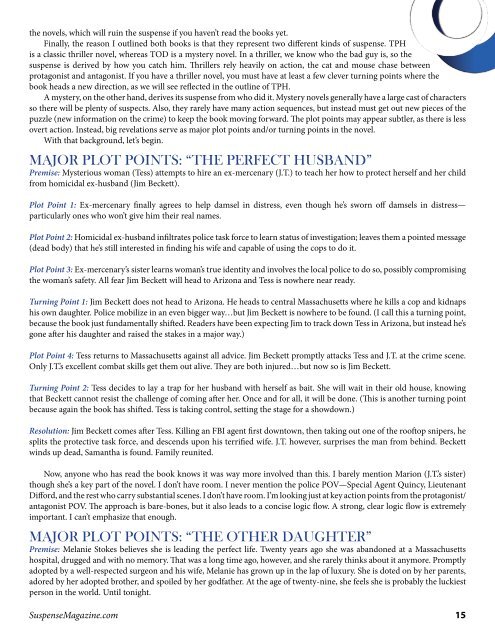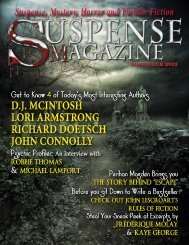Suspense Magazine July 2013
Suspense Magazine July 2013
Suspense Magazine July 2013
Create successful ePaper yourself
Turn your PDF publications into a flip-book with our unique Google optimized e-Paper software.
the novels, which will ruin the suspense if you haven’t read the books yet.<br />
Finally, the reason I outlined both books is that they represent two different kinds of suspense. TPH<br />
is a classic thriller novel, whereas TOD is a mystery novel. In a thriller, we know who the bad guy is, so the<br />
suspense is derived by how you catch him. Thrillers rely heavily on action, the cat and mouse chase between<br />
protagonist and antagonist. If you have a thriller novel, you must have at least a few clever turning points where the<br />
book heads a new direction, as we will see reflected in the outline of TPH.<br />
A mystery, on the other hand, derives its suspense from who did it. Mystery novels generally have a large cast of characters<br />
so there will be plenty of suspects. Also, they rarely have many action sequences, but instead must get out new pieces of the<br />
puzzle (new information on the crime) to keep the book moving forward. The plot points may appear subtler, as there is less<br />
overt action. Instead, big revelations serve as major plot points and/or turning points in the novel.<br />
With that background, let’s begin.<br />
Major Plot Points: “The Perfect Husband”<br />
Premise: Mysterious woman (Tess) attempts to hire an ex-mercenary (J.T.) to teach her how to protect herself and her child<br />
from homicidal ex-husband (Jim Beckett).<br />
Plot Point 1: Ex-mercenary finally agrees to help damsel in distress, even though he’s sworn off damsels in distress—<br />
particularly ones who won’t give him their real names.<br />
Plot Point 2: Homicidal ex-husband infiltrates police task force to learn status of investigation; leaves them a pointed message<br />
(dead body) that he’s still interested in finding his wife and capable of using the cops to do it.<br />
Plot Point 3: Ex-mercenary’s sister learns woman’s true identity and involves the local police to do so, possibly compromising<br />
the woman’s safety. All fear Jim Beckett will head to Arizona and Tess is nowhere near ready.<br />
Turning Point 1: Jim Beckett does not head to Arizona. He heads to central Massachusetts where he kills a cop and kidnaps<br />
his own daughter. Police mobilize in an even bigger way…but Jim Beckett is nowhere to be found. (I call this a turning point,<br />
because the book just fundamentally shifted. Readers have been expecting Jim to track down Tess in Arizona, but instead he’s<br />
gone after his daughter and raised the stakes in a major way.)<br />
Plot Point 4: Tess returns to Massachusetts against all advice. Jim Beckett promptly attacks Tess and J.T. at the crime scene.<br />
Only J.T.’s excellent combat skills get them out alive. They are both injured…but now so is Jim Beckett.<br />
Turning Point 2: Tess decides to lay a trap for her husband with herself as bait. She will wait in their old house, knowing<br />
that Beckett cannot resist the challenge of coming after her. Once and for all, it will be done. (This is another turning point<br />
because again the book has shifted. Tess is taking control, setting the stage for a showdown.)<br />
Resolution: Jim Beckett comes after Tess. Killing an FBI agent first downtown, then taking out one of the rooftop snipers, he<br />
splits the protective task force, and descends upon his terrified wife. J.T. however, surprises the man from behind. Beckett<br />
winds up dead, Samantha is found. Family reunited.<br />
Now, anyone who has read the book knows it was way more involved than this. I barely mention Marion (J.T.’s sister)<br />
though she’s a key part of the novel. I don’t have room. I never mention the police POV—Special Agent Quincy, Lieutenant<br />
Difford, and the rest who carry substantial scenes. I don’t have room. I’m looking just at key action points from the protagonist/<br />
antagonist POV. The approach is bare-bones, but it also leads to a concise logic flow. A strong, clear logic flow is extremely<br />
important. I can’t emphasize that enough.<br />
Major Plot Points: “The Other Daughter”<br />
Premise: Melanie Stokes believes she is leading the perfect life. Twenty years ago she was abandoned at a Massachusetts<br />
hospital, drugged and with no memory. That was a long time ago, however, and she rarely thinks about it anymore. Promptly<br />
adopted by a well-respected surgeon and his wife, Melanie has grown up in the lap of luxury. She is doted on by her parents,<br />
adored by her adopted brother, and spoiled by her godfather. At the age of twenty-nine, she feels she is probably the luckiest<br />
person in the world. Until tonight.<br />
<strong>Suspense</strong><strong>Magazine</strong>.com<br />
15
















